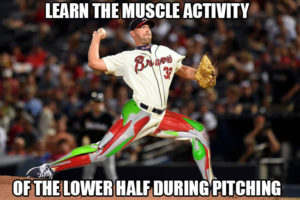 There are hundreds, maybe thousands, of studies on pitching performance that mainly focus on the upper body. The problem is energy comes from the lower half musculature interacting with the ground. These "ground reaction forces" is what the pitcher uses in his pitching mechanics to put force on the ball. So understanding how lower body muscle activity is contributing to pitching performance will show the pitcher where he should spend his time developing more strength and power to improve pitching performance.
There are hundreds, maybe thousands, of studies on pitching performance that mainly focus on the upper body. The problem is energy comes from the lower half musculature interacting with the ground. These "ground reaction forces" is what the pitcher uses in his pitching mechanics to put force on the ball. So understanding how lower body muscle activity is contributing to pitching performance will show the pitcher where he should spend his time developing more strength and power to improve pitching performance.
If you have ever had a coach or program that is built on the arm path only then after reading this article, you should now understand why these approaches are either void of any strength/power training or preach against it. At this point, you will need to step back and first make the decision for yourself, on what approach to pitching you believe in; upper body or total body? 3X Pitching is one approach that is built around the total body and its efficient and effective use of power.
In this article, I will not only cover two case studies that measured the muscle activity of both the drive and landing leg in the pitching delivery but I will also go over why you will never significantly increase pitching velocity in an approach that only addresses the upper half. I will also give you some excellent exercises and lifts for developing these lower half muscles to improve pitching performance.
Lower Body Muscle Activity in the Pitcher
Based on these case studies below, you will learn that the key muscles in the lower half contributing to pitching performance are the calf, glute, bicep femoris, abductor, and adductors. The most dominant in the first study is the calf in the drive leg and the glute in the landing leg. The calf is more than likely activating so high because it is the muscle that is close to the ground where the ground reaction forces are being generated and the glute is more than likely so high in the landing leg because it is the muscle that helps stabilize the hips to launch the trunk forward at front foot strike.
In the second study, the abductor is more dominant than the calf muscle in the drive leg and the adductor is more dominant in the landing leg but the glute is not measured in this study. More than likely the abductor is more dominant in the drive leg to help position the hips and align the drive leg force vector before force production. The adductor is more dominant in the landing leg because it works with the glute to help stabilize the hips by stabilizing the front knee at the front foot strike.
Look closer at these two studies to truly understand what is occurring in the lower half during the pitching delivery. This understanding will have a major impact on how you train for pitching performance.
Lower Half EMG Pitching Case Study #1
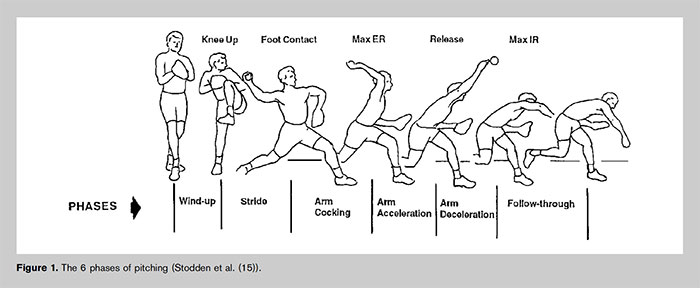
The pitching motion was divided into 4 distinct phases: phase 1, initiation of pitching motion to maximum stride leg knee height; phase 2, maximum stride leg knee height to stride foot contact (SFC); phase 3, SFC to ball release; and phase 4, ball release to 0.5 seconds after ball release (follow-through) (1).
Trail Leg Electromyography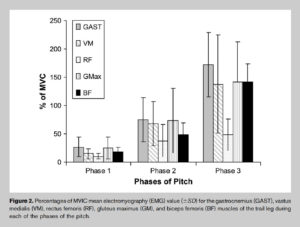 Figure 2 illustrates the mean muscle activity elicited from the trail leg during the first 3 defined phases of the pitch. Electromyography data for the trail leg was only reported for the first 3 phases of the pitch through ball release. After the ball release, the trail leg was not in contact with the ground; therefore, EMG data would not have any substantial value to the pitching motion. The trail leg elicited minimal to moderate amounts of muscle activity from all 5 of the muscles tested based on the standardized isometric contractions during phase 1. In phase 2, trail leg musculature elicited significantly greater muscle activity compared with phase 1. In phase 3, the trail leg musculature generally elicited the highest muscle activity for all 5 muscles tested during the first 3 defined phases of the pitch.
Figure 2 illustrates the mean muscle activity elicited from the trail leg during the first 3 defined phases of the pitch. Electromyography data for the trail leg was only reported for the first 3 phases of the pitch through ball release. After the ball release, the trail leg was not in contact with the ground; therefore, EMG data would not have any substantial value to the pitching motion. The trail leg elicited minimal to moderate amounts of muscle activity from all 5 of the muscles tested based on the standardized isometric contractions during phase 1. In phase 2, trail leg musculature elicited significantly greater muscle activity compared with phase 1. In phase 3, the trail leg musculature generally elicited the highest muscle activity for all 5 muscles tested during the first 3 defined phases of the pitch.
Stride Leg Electromyography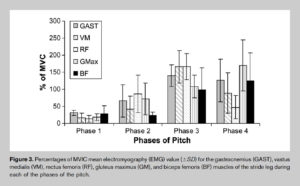 Figure 3 illustrates the mean muscle activity elicited from the stride leg musculature during all 4 of the defined phases of the pitch. The stride leg elicited minimal to moderate amounts of muscle activity from all 5 muscles tested based on the standardized isometric contractions during phase 1. In phase 2, stride leg musculature elicited moderate to significantly high amounts of muscle activity from all 5 muscles tested. In phases 3 and 4, stride leg musculature generally elicited significantly high amounts of muscle activity from 4 of the 5 muscles tested. The RF (47%) was the only muscle that did not show a high amount of muscle activity during phase 4 of the pitch.
Figure 3 illustrates the mean muscle activity elicited from the stride leg musculature during all 4 of the defined phases of the pitch. The stride leg elicited minimal to moderate amounts of muscle activity from all 5 muscles tested based on the standardized isometric contractions during phase 1. In phase 2, stride leg musculature elicited moderate to significantly high amounts of muscle activity from all 5 muscles tested. In phases 3 and 4, stride leg musculature generally elicited significantly high amounts of muscle activity from 4 of the 5 muscles tested. The RF (47%) was the only muscle that did not show a high amount of muscle activity during phase 4 of the pitch.
Lower Half EMG Pitching Case Study #2
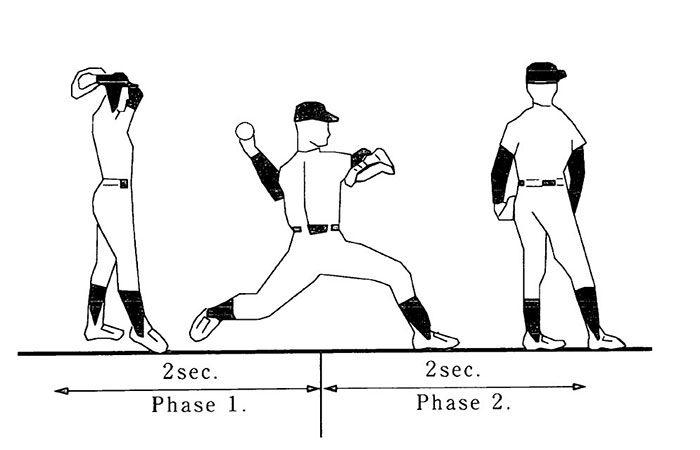
In this study, the first phase covered the 2 seconds immediately prior to the landing of the non-pivot leg. The second phase covered the following two seconds immediately after the landing of the non-pivot leg.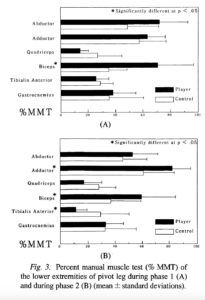
Pivot-leg, phase 1
The abductor, adductor, biceps, and gastrocnemius of the player group showed higher activity than those of the control group. In these muscles, the biceps contraction was highest in significance. The biceps showed 71% MMT (Table 1, Fig. 3A).
Pivot leg, phase 2
The abductor, adductor, biceps, and gastrocnemius of the player group showed higher activity than those of the control group. The adductor, biceps, and tibialis anterior were highest in significance. The adductor showed 83% MMT. The biceps showed 60% MMT. The tibialis anterior of the control group showed 29% MMT (Table 1, Fig. 3B).
Non pivot leg, phase 1
The abductor, adductor, and quadriceps showed higher activity than those of the control group. The adductor and quadriceps were highest in significance. The adductor showed 84% MMT. The quadriceps showed 48% MMT (Table 1, Fig. 4A).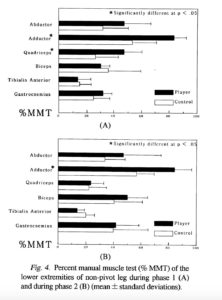
Non-pivot leg, phase 2
The abductor, adductor, and biceps of the player group showed higher activity than those of the control group. The adductor of the player group was highest in significance. The adductor showed 84% MMT (Table 1, Fig. 4B).
Exercises and Lifts to Develop the Lower Half for Pitching Performance
The calf and bicep femoris are easy to develop strength with lifts like squats and lunges. The most effective form of training to maximize power in these muscles is Olympic Lifts. You can also use plyometrics but I do not recommend plyos as an alternative for Olympic Lifts, just an addition. This is the 3X Pitching approach and the 3X Pitching Velocity Program comes with a periodization model to most effectively and safely increase pitching velocity with the Olympic Lifts through the off-season, pre-season and in-season.
The abductor and adductors are a lot harder to train. Exercises like the hip abductor and adductor machines are hard to come by and not that effective in training athleticism. I would recommend the Hip Routine in the 3X Pitching Level 3 program. You can also search YouTube for some exercises to train the abductors and adductors. It isn't much you can do to power-train these muscles. I would just focus on making them as strong as possible and also as flexible as possible with a good mobility training program. Your throwing program should use resistance or med ball throws to help improve the performance of the abductors and adductors. This is also the 3X Pitching approach. The 3X Pitching Velocity Program uses linear and lateral full stride throws with a 2lb med ball to train these muscles, along with sled drills.
Flawed Pitching Programs that Do Not Train Lower Half
Pitching programs that only load or focus on the upper half and do not put in the work to develop lower half strength, power, and motor control will never significantly enhance pitching performance. Many studies link the power and stability of the lower half to the effectiveness of the upper body. Check out these articles below to learn more about the science behind this ground-up understanding of pitching performance.
- Study Links Glute to Preventing Arm Injury for Pitchers
- Study: 3X Pitching Mechanics Reduce Arm Injury
- Studies Prove Hip Mobility Link to High Pitch Velocity
Lower Half Pitching Reference:
- Campbell BM, Stodden DF, Nixon MK. - Lower extremity muscle activation during baseball pitching - J Strength Cond Res. 2010 Apr;24(4):964-71.
- TOYOAKI YAMANOUCHI - Department of Orthopaedic Surgery, Kurume University School of Medicine, Kurume 830-0011, Japan - EMG Analysis of the Lower Extremities During Pitching in High-School Baseball - Kurume Medical Journal, 45, 21-25,1998



